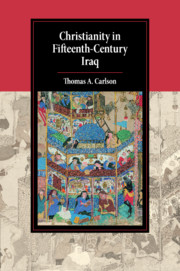Book contents
- Christianity in Fifteenth-Century Iraq
- Cambridge Studies in Islamic Civilization
- Christianity in Fifteenth-Century Iraq
- Copyright page
- Contents
- Figures
- Maps
- Acknowledgements
- Notes on Transliteration, Names, and Dates
- Abbreviations
- Maps
- Introduction
- 1 Coming into Focus: The World of Fifteenth Century Iraq and al-Jazīra
- 2 Muslim Lords and Their Christian Flocks
- 3 Living with Suspicious Neighbors in a Violent World
- 4 Interlude: Concepts of Communities
- 5 Bridges and Barriers of Doctrine
- 6 Practical Theology in a Dangerous Time
- 7 Rituals: The Texture of Belonging
- 8 Desperate Measures: The Changing Ecclesiastical Hierarchy
- 9 The Power of the Past: Communal History for Present Needs
- Conclusion
- Book part
- Bibliography
- Index
- Other Titles in the Series
- References
Bibliography
Published online by Cambridge University Press: 17 August 2018
- Christianity in Fifteenth-Century Iraq
- Cambridge Studies in Islamic Civilization
- Christianity in Fifteenth-Century Iraq
- Copyright page
- Contents
- Figures
- Maps
- Acknowledgements
- Notes on Transliteration, Names, and Dates
- Abbreviations
- Maps
- Introduction
- 1 Coming into Focus: The World of Fifteenth Century Iraq and al-Jazīra
- 2 Muslim Lords and Their Christian Flocks
- 3 Living with Suspicious Neighbors in a Violent World
- 4 Interlude: Concepts of Communities
- 5 Bridges and Barriers of Doctrine
- 6 Practical Theology in a Dangerous Time
- 7 Rituals: The Texture of Belonging
- 8 Desperate Measures: The Changing Ecclesiastical Hierarchy
- 9 The Power of the Past: Communal History for Present Needs
- Conclusion
- Book part
- Bibliography
- Index
- Other Titles in the Series
- References
- Type
- Chapter
- Information
- Christianity in Fifteenth-Century Iraq , pp. 275 - 290Publisher: Cambridge University PressPrint publication year: 2018

